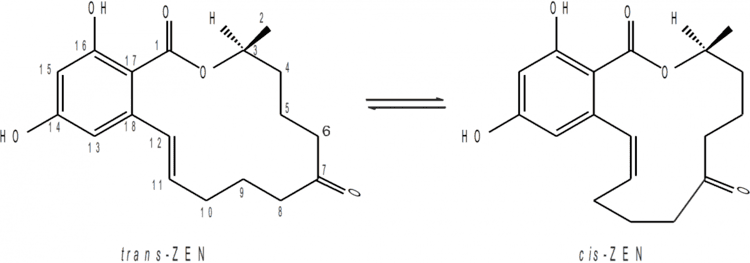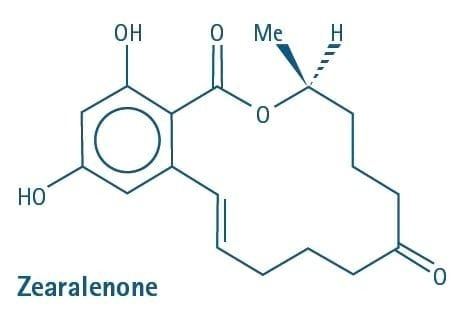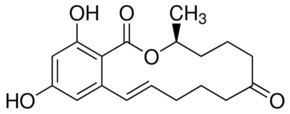Formula C18H22O5 | Molar mass 318.364 g/mol | |
 | ||
What does zearalenone mean
Zearalenone (ZEN), also known as RAL and F-2 mycotoxin, is a potent estrogenic metabolite produced by some Fusarium and Gibberella species. Particularly is produced by Fusarium graminearum, Fusarium culmorum, Fusarium cerealis, Fusarium equiseti, Fusarium verticillioides, and Fusarium incarnatum
Contents
- What does zearalenone mean
- Aflatoxin zearalenone deoxynivalenol melamine rapid test for feed and grains
- Chemical and physical properties
- Dermal exposure
- Reproduction
- Sampling and analysis
- References

Several Fusarium species produce toxic substances of considerable concern to livestock and poultry producers, namely deoxynivalenol, T-2 toxin, HT-2 toxin, diacetoxyscirpenol (DAS) and zearalenone. Zearalenone is the primary toxin, causing infertility, abortion or other breeding problems, especially in swine.

Zearalenone is heat-stable and is found worldwide in a number of cereal crops, such as maize, barley, oats, wheat, rice, and sorghum.

In addition to its actions on the classical estrogen receptors, zearalenone has been found to act as an agonist of the GPER (GPR30).

Aflatoxin zearalenone deoxynivalenol melamine rapid test for feed and grains
Chemical and physical properties

Zearalenone is a white crystalline solid. It exhibits blue-green fluorescence when excited by long wavelength ultraviolet (UV) light (360 nm) and a more intense green fluorescence when excited with short wavelength UV light (260 nm). In methanol, UV absorption maxima occur at 236 (e = 29,700), 274 (e = 13,909) and 316 nm (e = 6,020). Maximum fluorescence in ethanol occurs with irradiation at 314 nm and with emission at 450 nm. Solubility in water is about 0.002 g/100 mL. It is slightly soluble in hexane and progressively more so in benzene, acetonitrile, methylene chloride, methanol, ethanol, and acetone. It is also soluble in aqueous alkali.
Dermal exposure
Zearalenone can permeate through the human skin. However, no significant hormonal effects are expected after dermal contact in normal agricultural or residential environments.
Reproduction
The human and livestock exposure to ZEN through the diet poses health concern due to the onset of several sexual disorders and alterations in the development of sexual apparatus. There are reliable case reports of early puberty in girls chronically exposed to ZEN in various regions of the world.
Sampling and analysis
In common with other mycotoxins, sampling food commodities for zearalenone must be carried out to obtain samples representative of the consignment under test. Commonly used extraction solvents are aqueous mixtures of methanol, acetonitrile, or ethyl acetate followed by a range of different clean-up procedures that depend in part on the food and on the detection method in use. Thin-layer chromatography (TLC) methods and high-performance liquid chromatography (HPLC) are commonly used. HPLC alone is not sufficient, as it may often yield false positive results. Today, HPLC-MS/MS analysis is used to quantify and confirm the presence of zearalenone.
The TLC method for zearalenone is: normal phase silica gel plates, the eluent: 90% dichloromethane, 10% v/v acetone; or reverse phase C18 silica plates; the eluent: 90% v/v methanol, 10% water. Zearalenone gives unmistakable blue luminiscence under UV.
